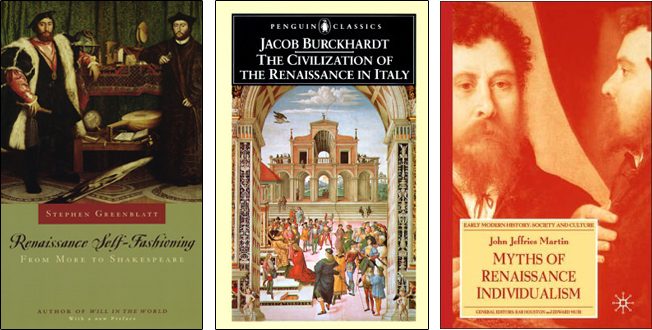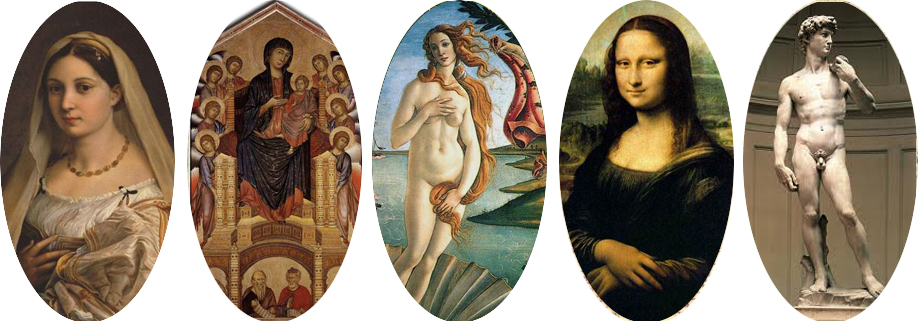The Renaissance was an era of cultural rebirth and achievement that occurred in Italy during the fourteenth, fifteenth, and sixteenth centuries. The period can be best described as the rise of humanism, which was an intellectual movement that emphasized secular ideas found in literature from Ancient Greece and Rome.
Among these ancient ideas was a newfound faith in the individual. The God-fearing Middle Ages viewed man as “unworthy by virtue” and “stained by original sin”.[1] However, as Renaissance Humanism brought a newfound interest in education in art and the humanities, people became less absorbed in religious hierarchy and more curious about the capabilities of man. As the Renaissance developed, Individualism became a prominent theme in Italy. Many philosophers wrote about the potential of man and developed their own beliefs as to the kind of person an individual should aim to be. These views inspired many people to invest in their studies of the arts and humanities, and as a result, many significant achievements came out of the Renaissance.
This guide provides a comprehensive view of the development of individual identity during the Renaissance. It is divided into five sections, which present both primary and secondary sources to present a complete understanding of the subject. The first section provides a “General Overview” of Renaissance Individualism. The following three sections highlight main themes within Renaissance Individualism: “The Origins of Individualism”, “The Renaissance Man”, and “Individualism in Renaisance Art”. The final section lists other electronic sources that provide additional information about humanism, individualism, and the Renaissance era as a whole.
Lukes, Steven. “The Meanings of “Individualism”.” Journal of the History of Ideas 31.1 (1971): 45-66. Print.
- Defines individualism by examining meanings various cultures attributed to the term in it’s nineteenth century origins. On page 58 and 59, Lukes discusses renaissance individualism by examining the ideas presented in The Development of The Individual written by renaissance scholar Jacob Burckhardt. Additionally, Lukes analyzes the modern significance of individualism and how the concept has evolved since it’s origins.
Humanism by the Encyclopedia Britannica
- Examines a history of Renaissance Humanism and traces how it’s ideals and ideologies were used in Renaissance literature, art, religion, and more. One section, titled “The emergence of the individual and the idea of the dignity of man”, discusses famous humanists’ ideas of individualism and helps explain the changes these ideas made to how people thought about man. Another section titled “Anthropocentricity and individualism” illustrates how the rise in individualism influenced a shift in the subjects of new Renaissance art.
Cassirer, Ernst. The individual and the cosmos in Renaissance philosophy. New York: Harper & Row, 1963. Print.
- Provides a detailed account of Renaissance philosophy. Cassirer examines how the Renaissance broke with midevil tradition and brought about changes to literature, art, and philosophy. He also describes the new ideologies of individualism that emerged as people began to break from the religious hierarchy of the Middle Ages.
Although most historians recognize the prominence of individualism during the Renaissance, there has been much debate between scholars about the origins and historical development of the “emergence of the individual”. The following sources include major works and scholarly comparisons of the different theories of individualism.
Jacob Burckhardt. The civilization of the Renaissance in Italy. New York: Modern Library, 1995.
- This famous essay presents an analytical historiography of Individualism. He examines the prominence of individualism 14th century culture of the Italian city-state and the ideologies of famous Renaissance philosophers. The essay has been the subject of much discussion and debate amongst Renaissance scholars.
Greenblatt, Stephen. Renaissance self-fashioning: from More to Shakespeare. Chicago: University of Chicago Press, 1980. Print.
- This book seeks to provide a history of individualism using new-historicism, a method of understanding history by analyzing the literature of a given time period. Greenblatt presents the idea that the emergence of the individual during the Renaissance was not a result of a break with the middle ages, nor did it influence the literary and artistic achievements that came out of the Renaissance. Instead, Greenblatt uses specific works to support his claim that individual identity was a “poetic” concept that emerged from the literary works of the Renaissance.
Martin, John Jeffries. Myths of Renaissance individualism. Houndmills, Basingstoke, Hampshire: Palgrave Macmillan, 2006. Print.
- This book presents an argument on popular theories of Renaissance Individualism. Martin critically analyzes the works of Burckhardt, Greenblatt, and other famous Renaissance scholars. He presents a unique perspective on individual progress, which he supports using careful examination of the social history and literary artifacts from 15th and 16th century Venice.
As the individual became increasingly important during the Renaissance, many philosophers developed their own ideas of a “perfect” individual. A Renaissance Man, or a man who is capable and knowledgeable of all things, can be found in the writings of many Renaissance philosophers.
The following primary sources are direct works from famous Renaissance Philosophers that discuss the concept of the ‘Renaissance Man’:
Mirandola, Giovanni. Oration on the dignity of man. Washington, D.C.: Regnery Publications, 1996. Print.
- This book, written by famous Renaissance philosopher and humanist Pico della Mirandola, is known as the “Manifesto of the Renaissance”[2]. It describes man as a dignified being, created by God to achieve his highest potential. The book cites important biblical figures and books to prove his theory that humans were intended to exercise their intellectual capacities and make themselves into the person they desired. His theories inspired many people to study the humanities as he encouraged people to become an expert in all subjects.
Castiglione, Baldassarre. The book of the courtier. London & Toronto/New York: JMDent & Sons, ltd./EPDutton co., 1928.
- Amidst a culture that placed high value on “civilized man”, Baldassar Castiglione’s work discusses the perfect Renaissance Courtier, or attendant of the Royal court. Castiglione explains his idea of a ‘Renaissance Man’ as one who is not only well-versed in the humanities and arts, but one who also exemplifies proper behavior and carries himself with elegance.
Elmer, Peter, Nick Webb, and Roberta Wood. The Renaissance in Europe: an anthology. New Haven: Yale University Press, 2000. Print.
- This book presents a collection of original documents and artifacts from the Renaissance and analyzes how they contributed to the historical significance of the era. The works are divided into five thematic sections. The first two sections concentrate on Renaissance Humanism and include works from famous philosophers like Machiavelli, Villani, and Pico della Mirandola. The book compares the different philosophies on individual development and evaluates the impact these views had on Renaissance society as a whole.
Other works on the subject:
Heller, Agnes. Renaissance man. London; Boston: Routledge & KPaul, 1978.
- Heller presents a detailed analysis of the Renaissance individual. She highlights works from famous Renaissance philosophers and discusses how their ideas combined with the fertile ground for cultural and artistic achievement influenced individuals to aim for high achievement.
Renaissance Man: Leonardo Da Vinci – the Museum of Science
- Leonardo Da Vinci is often regarded as the epitome of a Renaissance Man. This site examines Da Vinci’s life and analyzes the talents and contributions that contributed to his legacy as a “universal person”.
The idea that man was capable of great accomplishment inspired many artists to pursue their studies in the arts and humanities. During the Middle Ages, people believed that only God had the power to create. The Renaissance, however, gave credit to artistic creativity and achievement. Artists started to take pride in their artwork and began exploring new humanist themes in their art rather than focusing on the traditional biblical subject matter that was popular during the middle ages.
The Renaissance in Florence – East Tennessee State University
- This site offers a comprehensive explanation of humanist subject matter during the Renaissance. It provides pictures of paintings and sculptures, explaining how individual thought influenced the humanist subject matter that was portrayed. Additionally, it provides a brief overview of the Renaissance and the patronage that made artistic achievement possible.
The Early Renaissance in Florence – The National Gallery of Art
- This website, sponsored by the National Gallery of Art, offers a virtual tour through the Early Renaissance in Florence. It gives a general overview of the time period and identifies it’s prominent perspectives and themes. The website identifies a newfound focus on individual achievement as one of the primary influences for new styles and subjects that emerged and provides examples of Renaissance art that reflected this focus.
Renaissance Conceptions of Man – SUNY Oneonta
- Provides an explanation for how the Renaissance philosophy of the individual influenced major achievements in Renaissance culture and thought. Examines excerpts from humanist philosophers and different forms of Renaissance artwork.
Video: “The Renaissance” – History.com
- The History Channel presents a history of the Renaissance using an original song and colorful illusrations. Although the video is rather playful, it presents important information from the time period in a fun and interesting way. Towards the end of the video (around 2:10), the song evaulates the Renaissance man and the achievements that came out of the new ways of individualism thinking.
Bibliography (for quotes used):
[1] Merriman, John M.. A history of modern Europe: from the Renaissance to the present. New York: W.W. Norton, 1996. 59. Print.
[2] Cheyney, Liana. “Humanism & Philosophical Background: Neoplatonism, Ficino and Pico.” Italian Renaissance Art. University of Massachusetts Lowell, n.d. Web. 10 Apr. 2013. <http://faculty.uml.edu/CulturalStudies/Italian_Renaissance/8_9_c.htm>.





